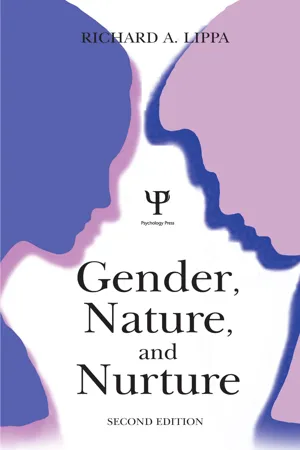
- 312 pages
- English
- ePUB (mobile friendly)
- Available on iOS & Android
Gender, Nature, and Nurture
About This Book
This engaging text presents the latest scientific findings on gender differences, similarities, and variations--in sexuality, cognitive abilities, occupational preferences, personality, and social behaviors. The impact of nature and nurture on gender is examined from the perspectives of genetics, molecular biology, evolutionary theory, neuroanatomy, sociology, and psychology. The result is a balanced, fair-minded synthesis of diverse points of view. Dr. Lippa's text sympathetically summarizes each side of the nature-nurture debate, and in a witty imagined conversation between a personified "nature" and "nurture, " he identifies weaknesses in the arguments offered by both sides. His review defines gender, summarizes research on gender differences, examines the nature of masculinity and femininity, describes theories of gender, and presents a "cascade model, " which argues that nature and nurture weave together to form the complex tapestry known as gender. Gender, Nature, and Nurture, Second Edition features:
*new research on sex differences in personality, moral thought, coping styles, sexual and antisocial behavior, and psychological adjustment;
*the results of a new meta-analysis of sex differences in real-life measures of aggression;
*new sections on non-hormonal direct genetic effects on sexual differentiation; hormones and maternal behavior; and on gender, work, and pay; and
*expanded accounts of sex differences in children's play and activity levels; social learning theories of gender, and social constructionist views of gender. This lively "primer" is an ideal book for courses on gender studies, the psychology of women, or of men, and gender roles. Its wealth of updated information will stimulate the professional reader, and its accessible style will captivate the student and general reader.
Frequently asked questions
Information
Table of contents
- Cover
- Half Title
- Title
- Copyright
- Dedication
- Contents
- Preface
- Introduction
- CHAPTER 1: WHAT'S THE DIFFERENCE ANYWAY?
- CHAPTER 2: MASCULINITY AND FEMININITY: GENDER WITHIN GENDER
- CHAPTER 3: THEORIES OF GENDER
- CHAPTER 4: THE CASE FOR NATURE
- CHAPTER 5: THE CASE FOR NURTURE
- CHAPTER 6: CROSS-EXAMINATIONS
- CHAPTER 7: GENDER, NATURE, AND NURTURE: LOOKING TO THE FUTURE
- Glossary of Key Terms and Concepts
- References
- Author Index
- Subject Index